Study on Shape Characteristics of Plastic Zone in Heterogeneous Roadway-Surrounding Rock
Abstract
:1. Introduction
2. Analytical Algorithm for Plastic Zone of Surrounding Rock in Heterogeneous Circular Roadway
2.1. Elastic Mechanics of Surrounding Rock of General Circular Roadway
2.2. Mechanical Model of Heterogeneous Circular Roadway Surrounding Rock
2.3. Shape of Plastic Zone in Surrounding Rock of Heterogeneous Circular Roadway
3. Shape Characteristics and Evolution Law of Plastic Zone
3.1. Shape Characteristics of Plastic Zone in Surrounding Rock of Single-Layer Heterogeneous Roadway
3.2. Shape Characteristics of Plastic Zone in Surrounding Rock of Multi-Layer Heterogeneous Composite Roadway
3.3. Directional Characteristics of Butterfly Shaped Plastic Zone
3.4. Shape Evolution of Plastic Zone
4. Error Analysis of Analytical Algorithm
4.1. Error Analysis of Plastic Zone Boundary of Single Layer Heterogeneous Surrounding Rock
4.1.1. Error Analysis of Plastic Zone Boundary under Isobaric Condition
4.1.2. Error Analysis of Plastic Zone Boundary under Non-Isobaric Conditions
4.2. Error Analysis of Plastic Zone Boundary of Multi-Layer Heterogeneous Composite Surrounding Rock
4.2.1. Error Analysis of Plastic Zone Boundary under Isobaric Condition
4.2.2. Error Analysis of Plastic Zone Boundary under Non-Isobaric Conditions
5. Discussion
5.1. Shape of Plastic Zone of Roadway Surrounding Rock
5.2. Range of Plastic Zone of Roadway Surrounding Rock
5.3. Comparison with Existing Experimental Results
6. Conclusions
- (1)
- The analytical algorithm proposed by this study uses several simple and commonly known independent variables to express the important unknown quantity of the range and shape of the plastic zone of the surrounding rock of the roadway, so that the functional relationship between them is clearer, and the failure law of the roadway can be revealed by studying the properties of the function, which is incomparable with other methods such as numerical simulation.
- (2)
- The comparison results show that the shape and range characteristics of the plastic zone obtained by the analytical algorithm are highly consistent with those obtained by the numerical simulation method, and are also consistent with the existing experimental results, so the analytical algorithm is effective. Compared with other methods, this method can guide field practice more conveniently and simply.
- (3)
- There are some errors between the analytical method and the numerical simulation. In addition, the relative error of the plastic zone calculation of a multi-layer heterogeneous roadway is larger than that of a single heterogeneous roadway. According to the accuracy required by the actual project, these problems can be ignored.
Author Contributions
Funding
Institutional Review Board Statement
Informed Consent Statement
Data Availability Statement
Conflicts of Interest
References
- Zou, H.; Yan, E.C. The surrounding rock deformation and failure mechanism of wudang group schists tunnel. Elec. J. Geot. Eng. 2015, 20, 6557–6576. [Google Scholar]
- Kang, H.P.; Xu, G.; Wang, B.M.; Wu, Y.Z.; Jiang, P.F.; Pan, J.F.; Ren, H.W.; Zhang, Y.J.; Pang, Y.H. Forty years development and prospects of underground coal mining and strata control technologies in China. J. Min. Strat. Control. Eng. 2019, 1, 7–39. [Google Scholar] [CrossRef]
- Yuan, C.; Cao, L.M.; Wang, W.J.; Fan, L.; Huang, C. Case study on rock support technology for roadways based on characteristics of plastic area. KSCE J. Civ. Eng. 2021, 25, 705–723. [Google Scholar] [CrossRef]
- Cai, M.F. Key theories and technonogies for surrounding rock stability and ground control in deep mining. J. Min. Strat. Control. Eng. 2020, 2, 5–13. [Google Scholar] [CrossRef]
- Palumbo, D.; Finis, R.D.; Ancona, F.; Galietti, U. Damage monitoring in fracture mechanics by evaluation of the heat dissipated in the cyclic plastic zone ahead of the crack tip with thermal measurements. Eng. Frac. Mech. 2017, 181, 65–76. [Google Scholar] [CrossRef]
- Zhang, T.; Wang, Y. Study on deformation evolution law and support technology of surrounding rock in multiple mining roadway. J. Min. Strat. Control. Eng. 2020, 2, 66–73. [Google Scholar] [CrossRef]
- Xia, C.C.; Liu, Y.P.; Wu, F.B.; Xu, C.; Deng, Y.G. Viscoelasto-viscoplastic solutions for circular tunnel based on nishihara model. Rock Soil Mech. 2019, 40, 1638–1648. [Google Scholar] [CrossRef]
- Eugie, K.; Murat, K.; Emmanuel, K.C. Proposed solution for the ground reaction of non-circular tunnels in an elastic-perfectly plastic rock mass. Comput. Geotech. 2020, 119, 103354. [Google Scholar] [CrossRef]
- Jiang, B.S.; Zhang, Q.; He, Y.N.; Han, L. Elastoplanstic analysis of cracked surrounding rocks in deep circular openings. Chin. J. Rock Mech. Eng. 2007, 26, 982–986. [Google Scholar] [CrossRef]
- Wang, Z.Q.; Wu, C.; Shi, L.; Su, Z.H.; Wang, P.; Huang, X. Analysis of surrounding rock stress and plastic zone of two-way unequal pressure circular roadway based on complex variable theory. J. China Coal Soc. 2019, 44, 419–429. [Google Scholar] [CrossRef]
- Zeng, K.; Ju, H.; Sheng, G.; Zhang, C.G. Elastic-plastic analytical solutions for surrounding rocks of tunnels and its engineering applications. J. China Coal Soc. 2011, 36, 752–755. [Google Scholar] [CrossRef]
- Kastner, H. Statik des Tunel und Stollenbauess; Springer: Berlin/Heidelberg, Germany, 1962. [Google Scholar]
- Ren, Q.; Zhang, H. The correction of Fenner formula. J. Hehai Univ. 2001, 29, 109–111. [Google Scholar]
- Bagheri, B.; Soltani, F.; Mohammadi, H. Prediction of plastic zone size around circular tunnels in non-hydrostatic stress field. Int. J. Min. Sci. Technol. 2014, 24, 81–85. [Google Scholar] [CrossRef]
- Pan, Y.; Chen, Y. Plastic zones and characteristics-line families for openings in elasto-plastic rock mass. Rock. Mech. Rock Eng. 1990, 23, 275–292. [Google Scholar] [CrossRef]
- Zhao, Z. Study on Mechanism and Control Method of Deformation and Failure of Surrounding Rock in Large Deformation Mining Roadway. Master’s Thesis, China University of Mining and Technology (Beijing), Beijing, China, 2014. [Google Scholar]
- Guo, X.F.; Zhao, Z.Q.; Gao, X.; Wu, X.; Ma, N. Analytical solutions for characteristic radii of circular roadway surrounding rock plastic zone and their application. Int. J. Min. Sci. Technol. 2019, 29, 263–272. [Google Scholar] [CrossRef]
- Zhao, Z.; Ma, N.; Guo, X.; Zhao, X. Falling principle and support design of butterfly-failure roof in large deformation mining roadways. J. China Coal Soc. 2016, 41, 2932–2939. [Google Scholar] [CrossRef]
- Ma, N.; Zhao, X.; Zhao, Z.; Li, J.; Guo, X.F. Stability analysis and control technology of mine roadway roof in deep mining. J. China Coal Soc. 2015, 40, 2287–2295. [Google Scholar] [CrossRef]
- Zhang, W.; Ma, N.; Ma, J.; Li, C.; Ren, J. Mechanism of rock burst revealed by numerical simulation and energy calculation. Shock. Vib. 2020, 2020, 8862849. [Google Scholar] [CrossRef]
- Wang, P.; Zhang, B.; Wang, L.; Lin, X.; Song, X.; Guo, J. Research on roof falling mechanism and support technology of mining roadway in expansive soft rock. J. Min. Strat. Control. Eng. 2020, 2, 57–65. [Google Scholar] [CrossRef]
- Guo, X.F.; Li, C.; Huo, T.H. Shapes and formation mechanism of the roadway plastic zone under partial confining pressure. Geomech. Eng. 2021, 25, 509–520. [Google Scholar] [CrossRef]
- Kong, P.; Jiang, L.; Shu, J.; Sainoki, A.; Wang, Q. Effect of fracture heterogeneity on rock mass stability in a highly heterogeneous underground roadway. Rock Mech. Rock Eng. 2019, 52, 4547–4564. [Google Scholar] [CrossRef]
- Dai, S.; Gao, W.; Wang, C.; Xiao, T. Damage evolution of heterogeneous rocks under uniaxial compression based on distinct element method. Rock Mech. Rock Eng. 2019, 52, 2631–2647. [Google Scholar] [CrossRef]
- Wang, J.; Wang, Z.; Yang, S. A coupled macro- and meso-mechanical model for heterogeneous coal. Int. J. Rock. Mech. Min. 2017, 94, 64–81. [Google Scholar] [CrossRef]
- Zhang, B.; Chalaturnyk, R.; Boisvert, J. A numerical characterization workflow for assessing the strength and failure modes of heterogeneous oil sands. Can. Geotech. J. 2020, 58, 763–781. [Google Scholar] [CrossRef]
- Jozef, J.; Karpiński, R.; Wójcik, A. Influence of the undercut anchor head angle on the propagation of the failure zone of the rock medium. Materials 2021, 14, 2371. [Google Scholar] [CrossRef]
- Jozef, J.; Karpiński, R.; Wójcik, A. Numerical analysis of the effect of embedment depth on the geometry of the cone failure. J. Phys. Conf. Ser. 2021, 2130, 012012. [Google Scholar] [CrossRef]
- Jozef, J.; Karpiński, R.; Wójcik, A. Influence of the undercut anchor head angle on the propagation of the failure zone of the rock medium-Part II. Materials 2021, 14, 3880. [Google Scholar] [CrossRef]
- Chen, H.; Zhu, H.; Zhang, L. Analytical solution for deep circular tunnels in rock with consideration of disturbed zone, 3d strength and large strain. Rock Mech. Rock Eng. 2021, 54, 1391–1410. [Google Scholar] [CrossRef]
- Eyvind, A.; Daniela, K.; Václav, V.; Soldal, M.; Oye, V. Experimental investigation of acoustic emissions and their moment tensors in rock during failure. Int. J. Rock. Mech. Min. 2014, 70, 286–295. [Google Scholar] [CrossRef]
- Li, C.J.; Li, X.B.; Li, D.Y. Particle flow analysis of fracture characteristics of marble with a single hole. Chin. J. Eng. 2017, 39, 1791–1801. [Google Scholar] [CrossRef]

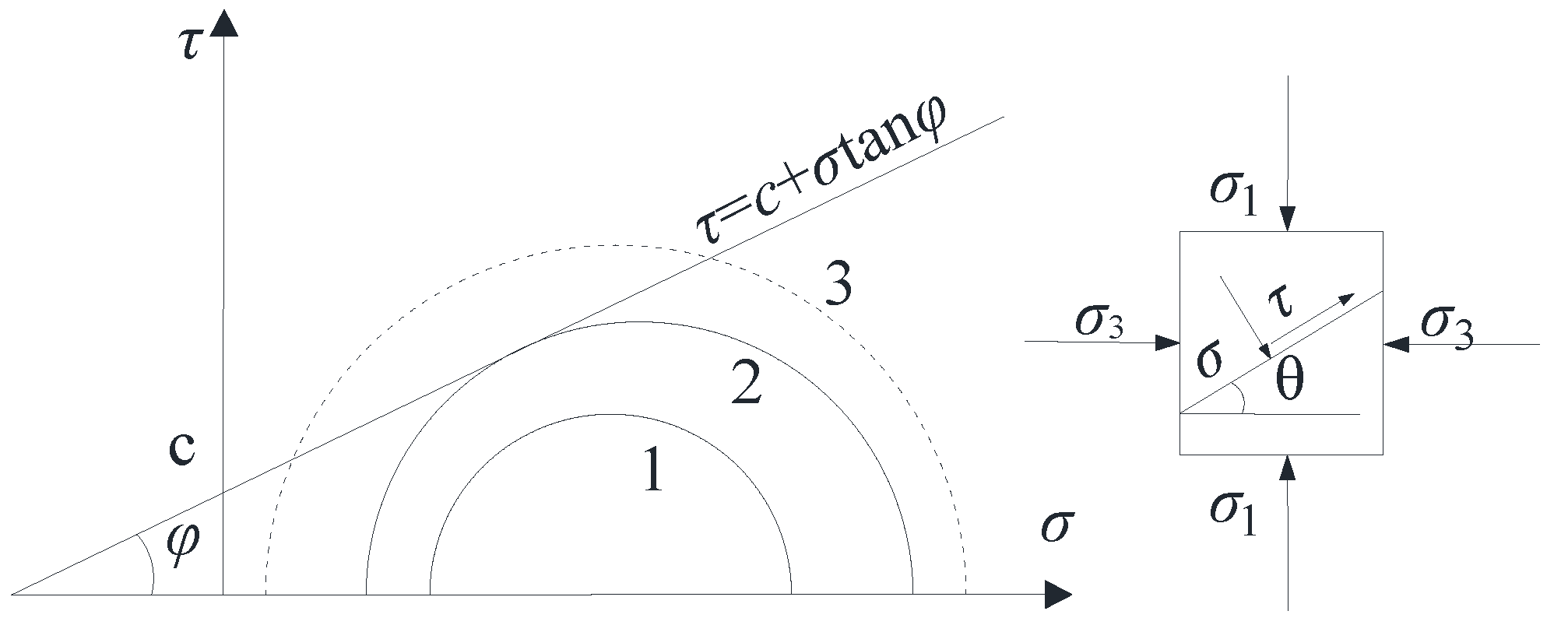
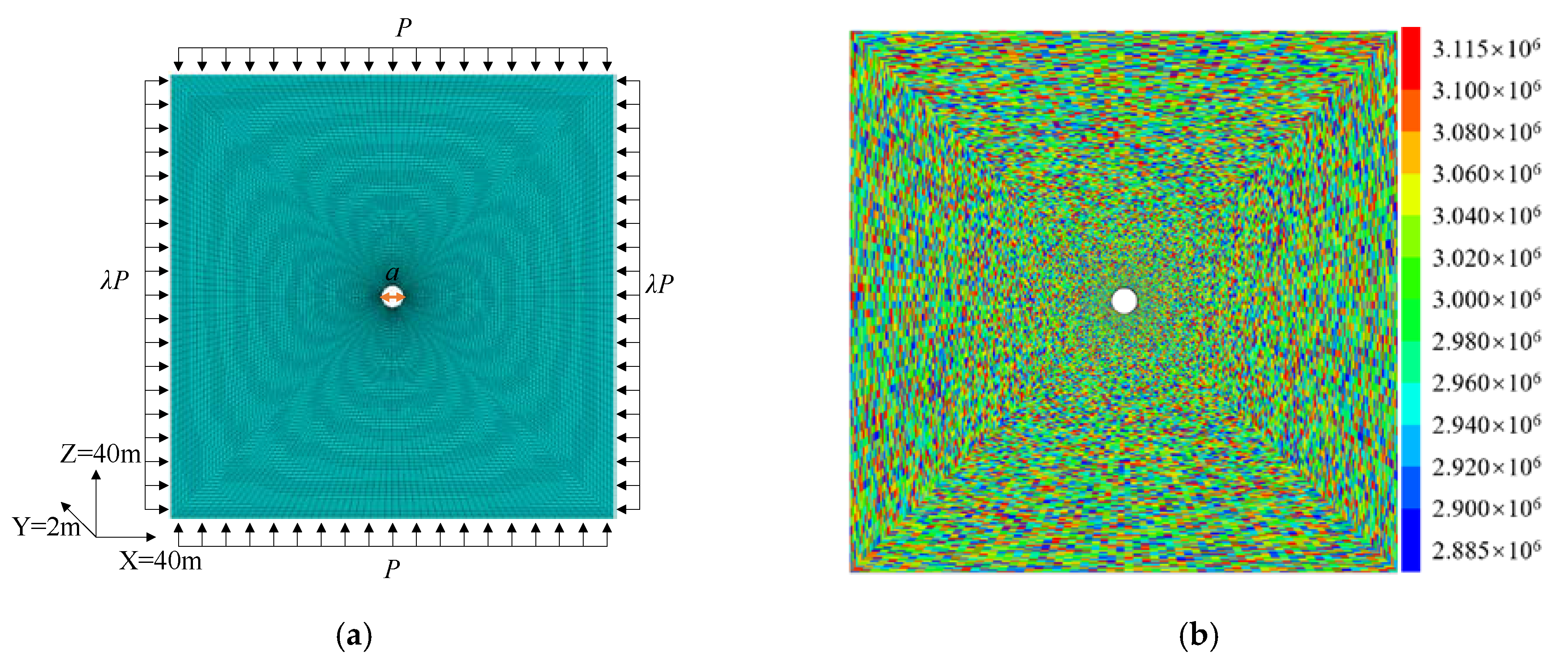


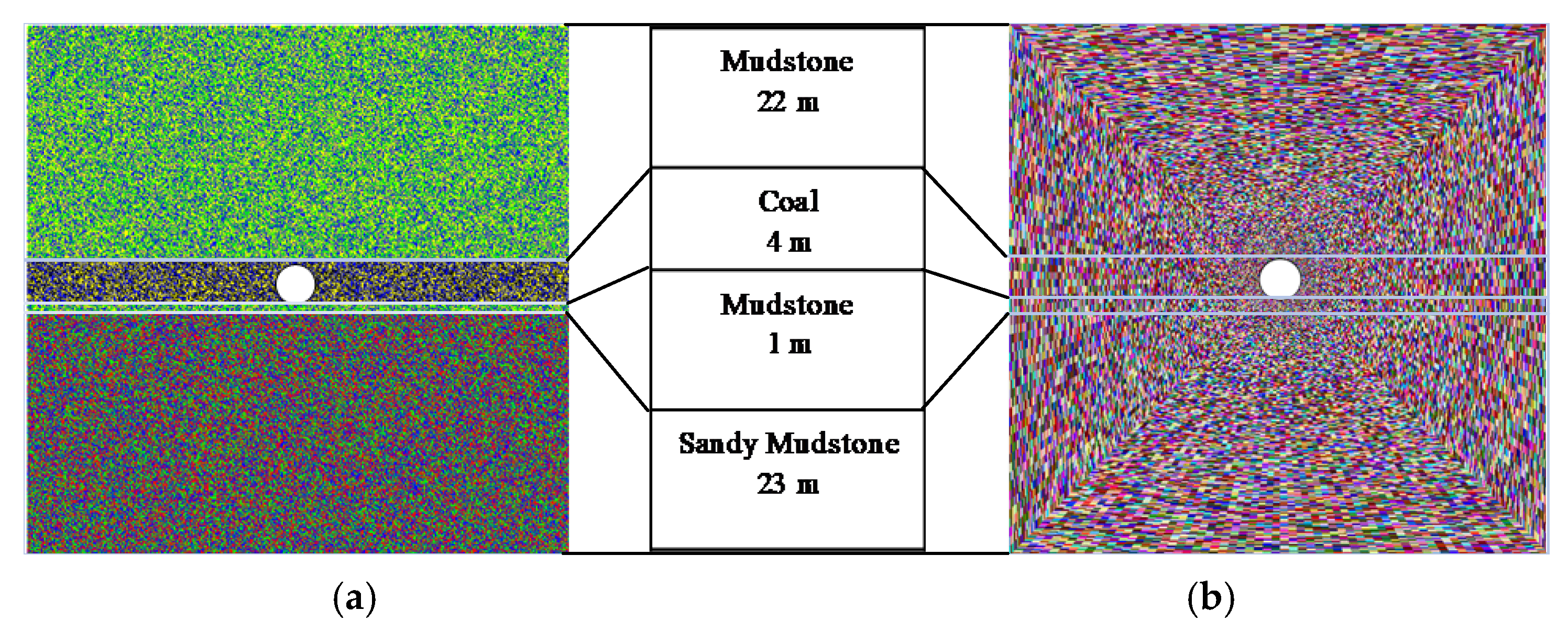
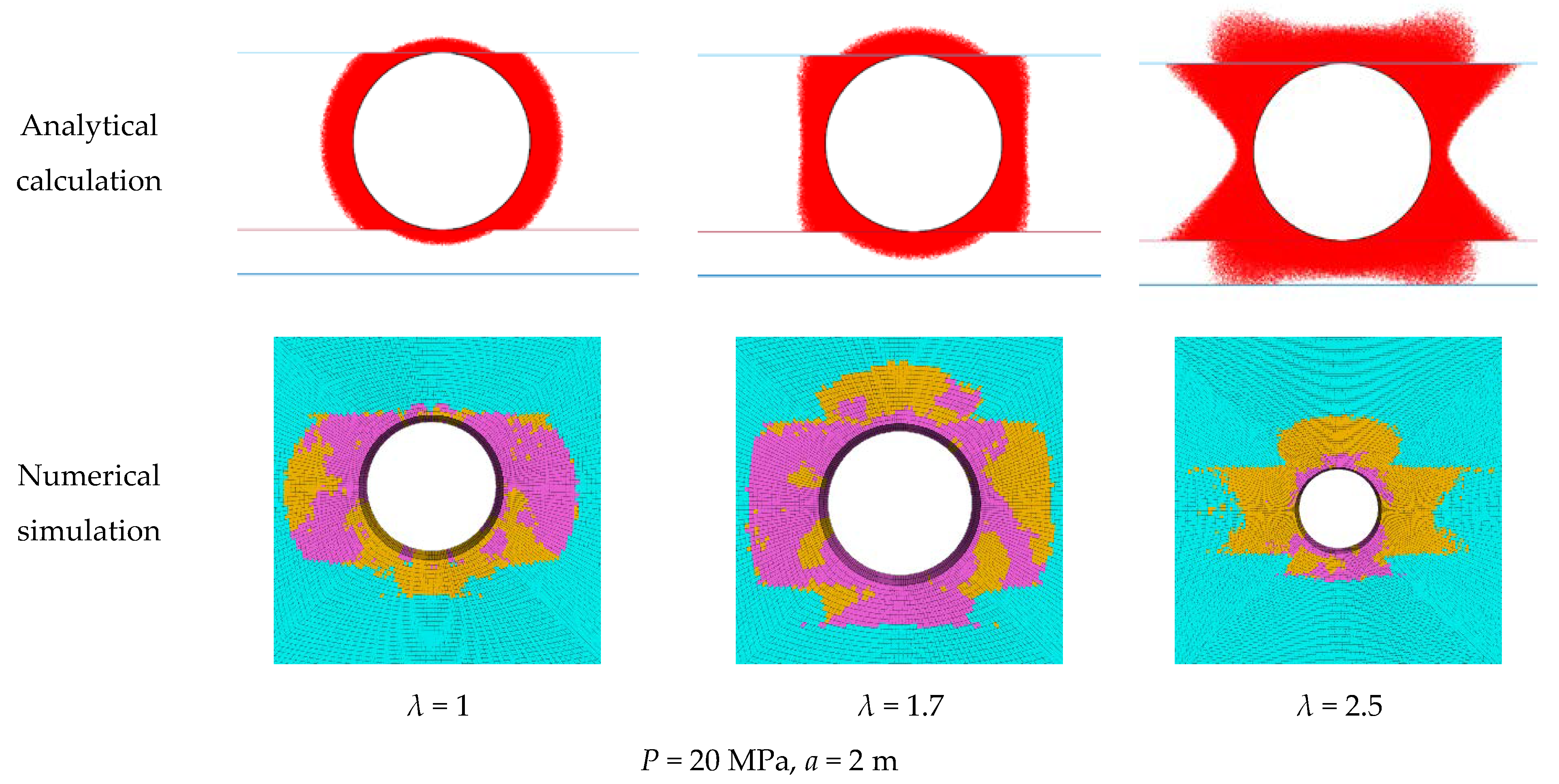
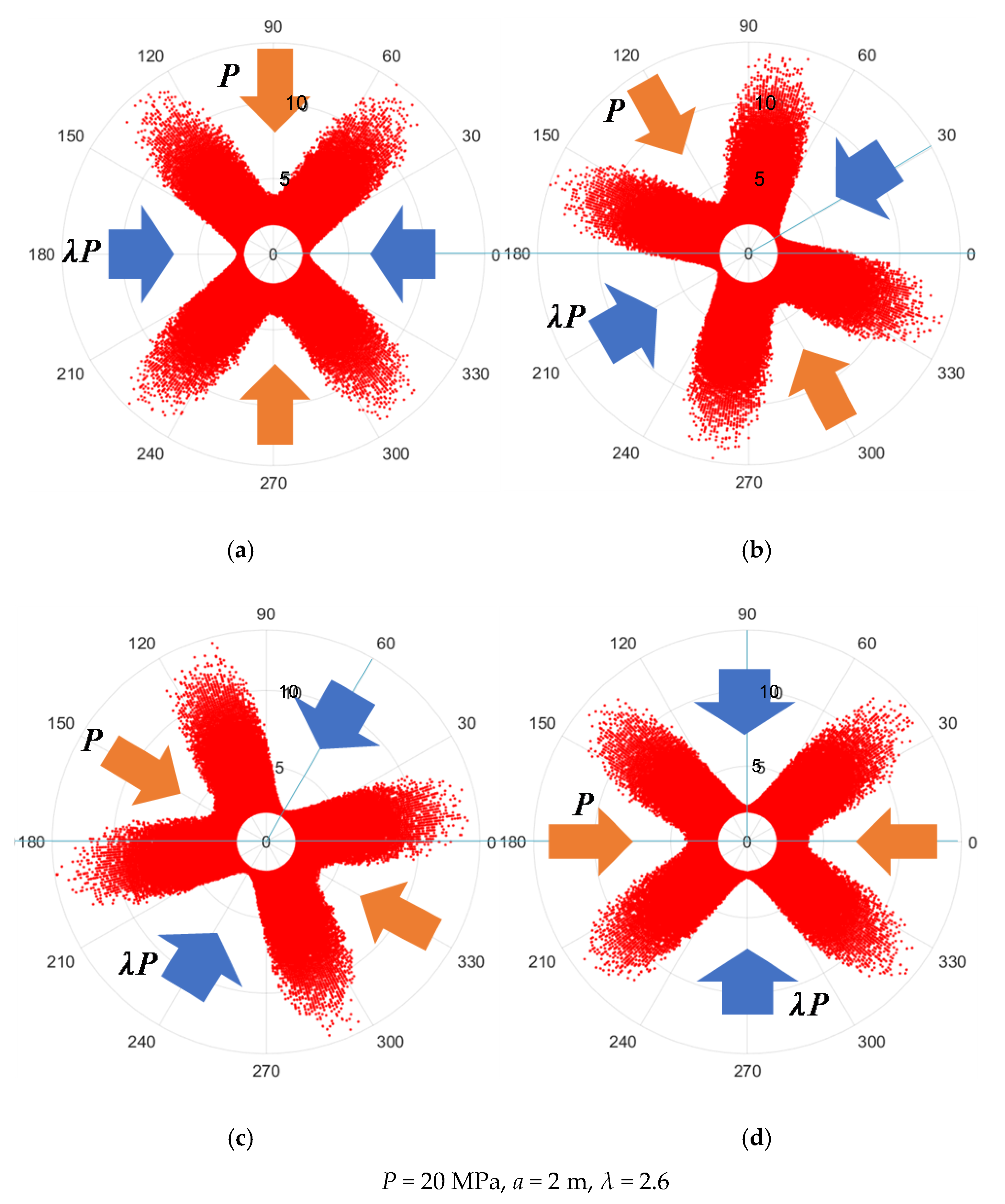


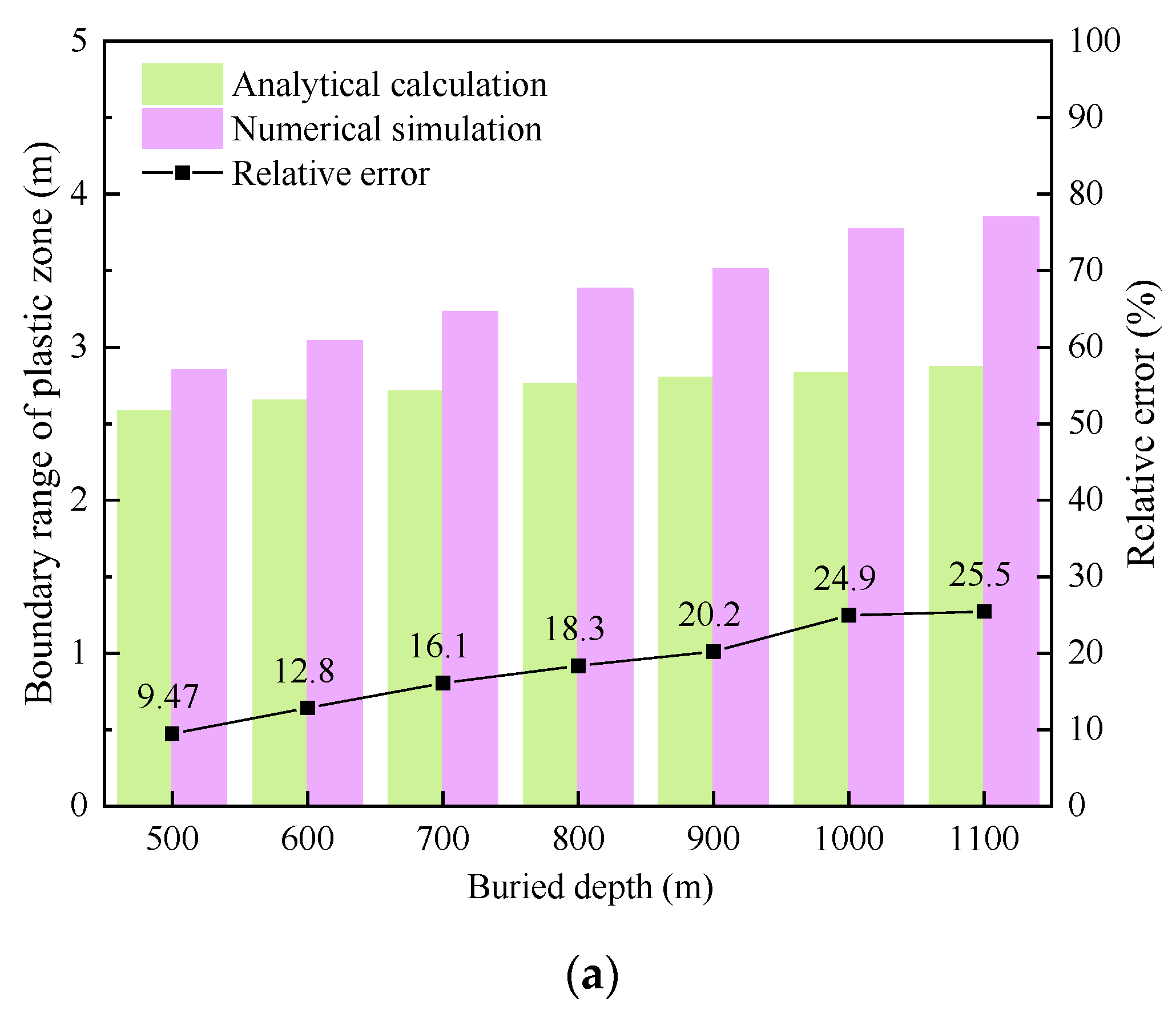

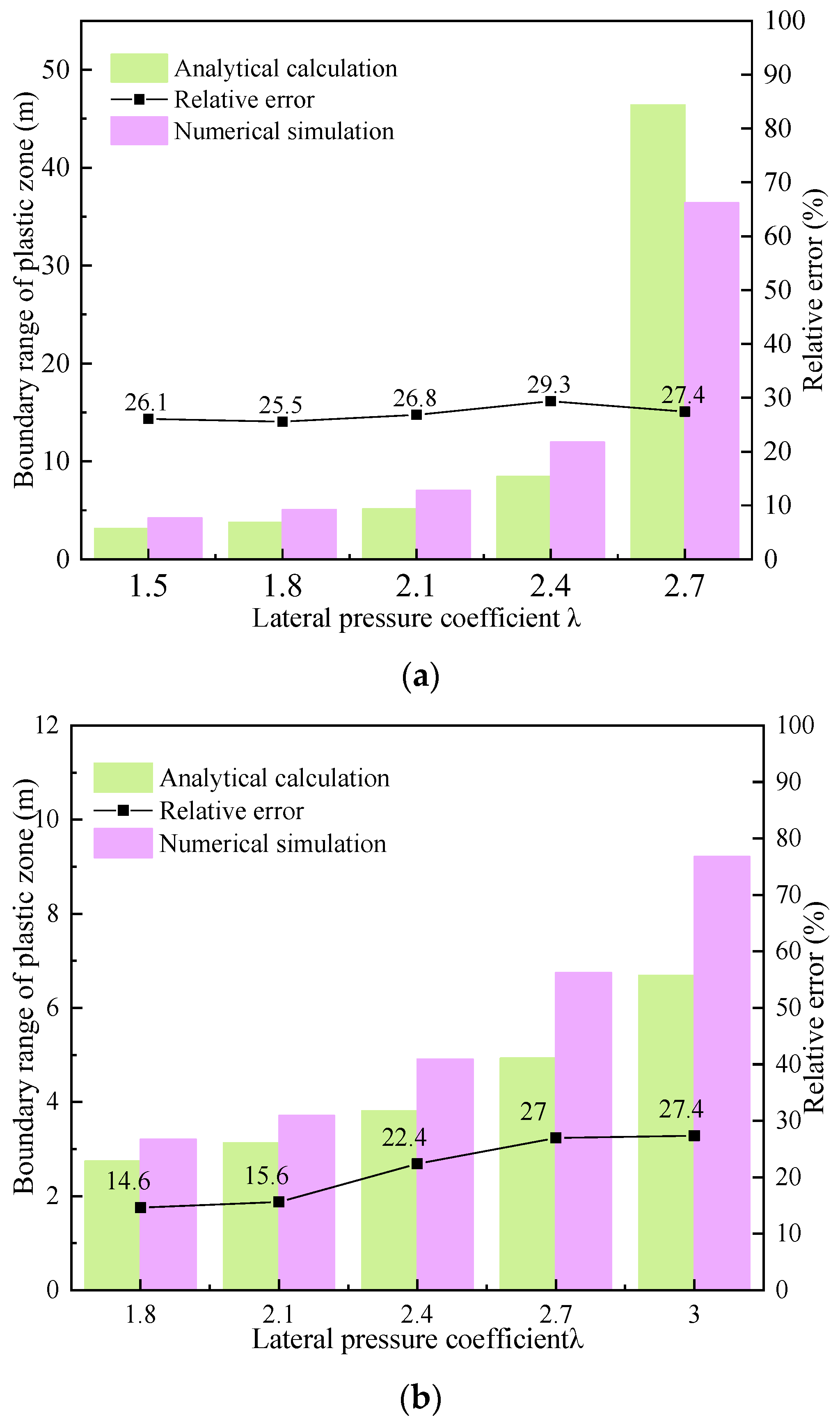

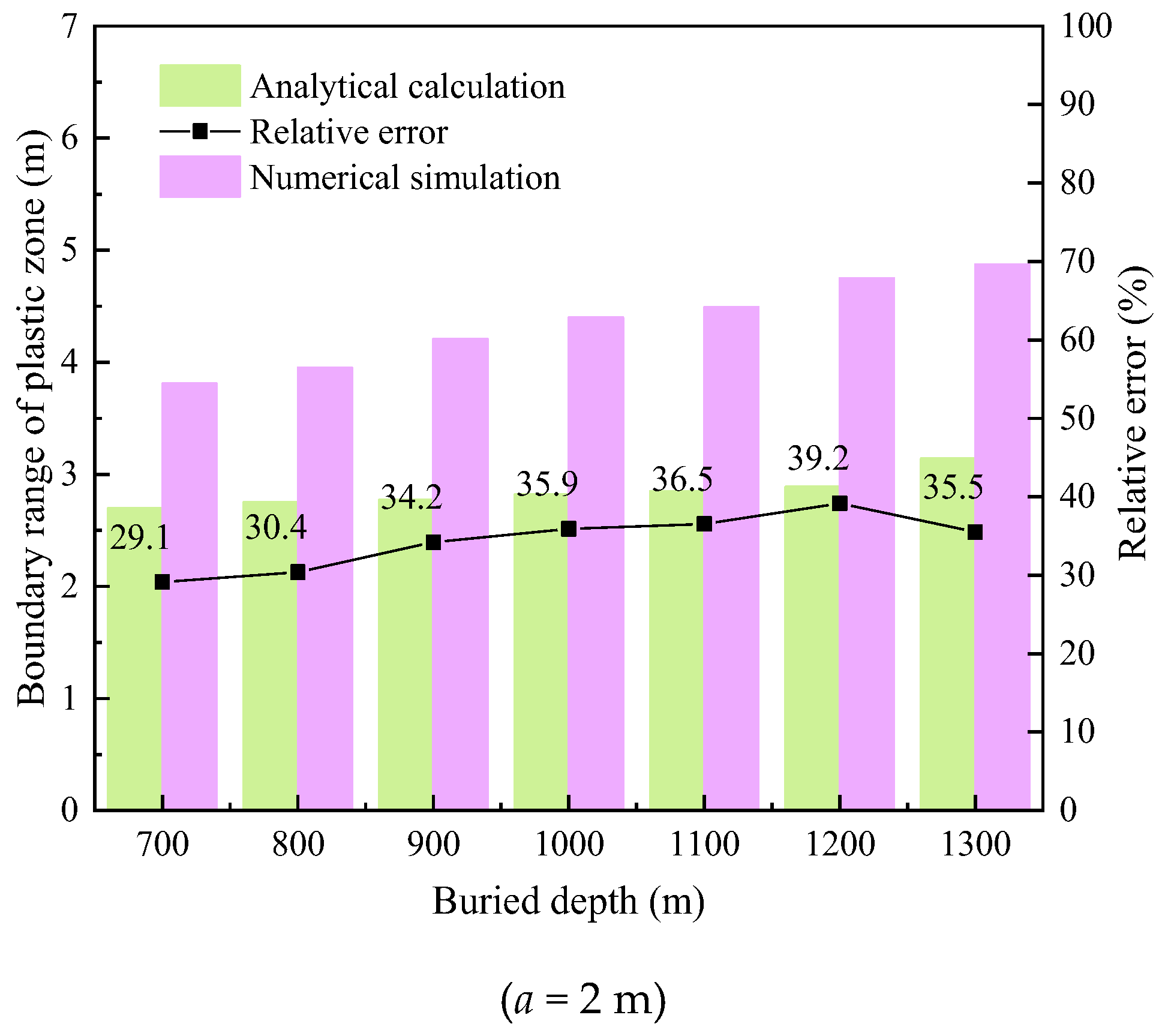
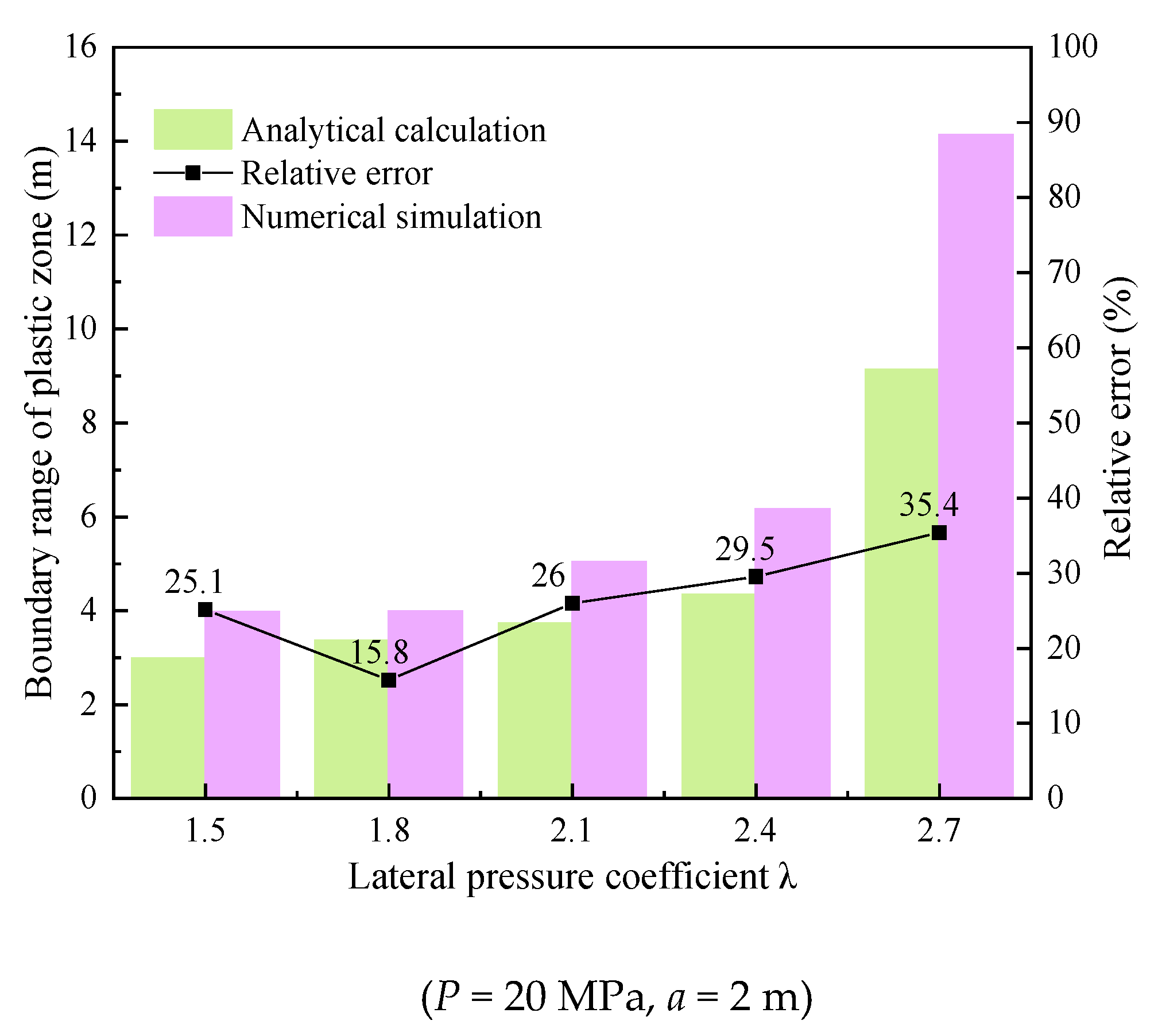
| Rock | Tensile Strength/MPa | Friction Angle/(°) | Cohesion/MPa | Elastic Modulus/GPa | Poisson’s Ratio | Compressive Strength/MPa |
|---|---|---|---|---|---|---|
| coal | 0.35 | [23, 28] | [2.8, 3.2] | 22.96 | 0.23 | 9.42 |
| mudstone | 1.91 | [27, 33] | [5.7, 6.3] | 10.35 | 0.24 | 20.78 |
| sandy mudstone | 4.39 | [32, 38] | [8.7, 9.3] | 2.69 | 0.22 | 34.57 |
Publisher’s Note: MDPI stays neutral with regard to jurisdictional claims in published maps and institutional affiliations. |
© 2022 by the authors. Licensee MDPI, Basel, Switzerland. This article is an open access article distributed under the terms and conditions of the Creative Commons Attribution (CC BY) license (https://creativecommons.org/licenses/by/4.0/).
Share and Cite
Li, J.; Wu, Z.; Zhang, W.; Ma, N.; Guo, S. Study on Shape Characteristics of Plastic Zone in Heterogeneous Roadway-Surrounding Rock. Sustainability 2022, 14, 9480. https://doi.org/10.3390/su14159480
Li J, Wu Z, Zhang W, Ma N, Guo S. Study on Shape Characteristics of Plastic Zone in Heterogeneous Roadway-Surrounding Rock. Sustainability. 2022; 14(15):9480. https://doi.org/10.3390/su14159480
Chicago/Turabian StyleLi, Jun, Zheng Wu, Wenlong Zhang, Nianjie Ma, and Shuying Guo. 2022. "Study on Shape Characteristics of Plastic Zone in Heterogeneous Roadway-Surrounding Rock" Sustainability 14, no. 15: 9480. https://doi.org/10.3390/su14159480






